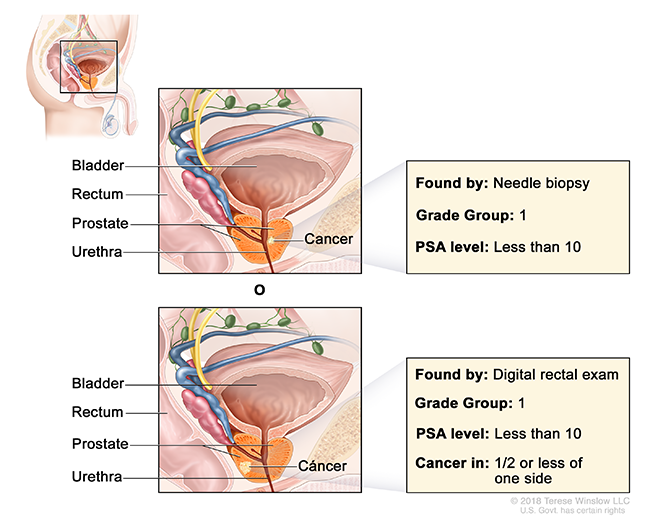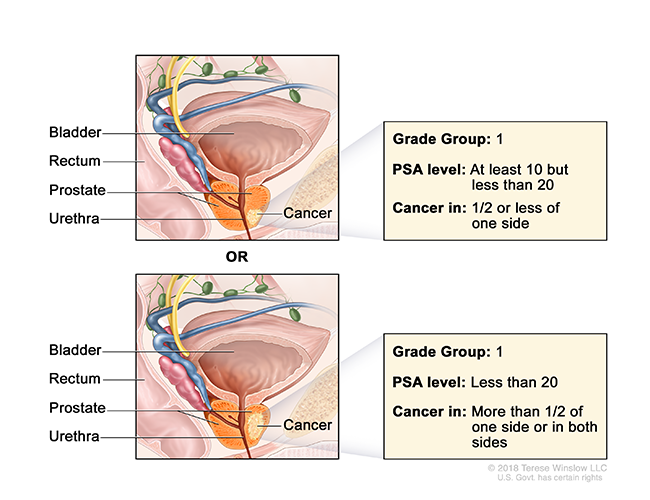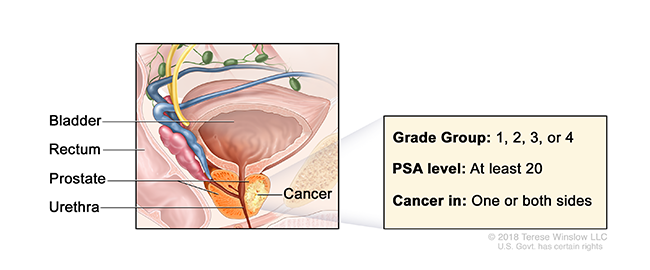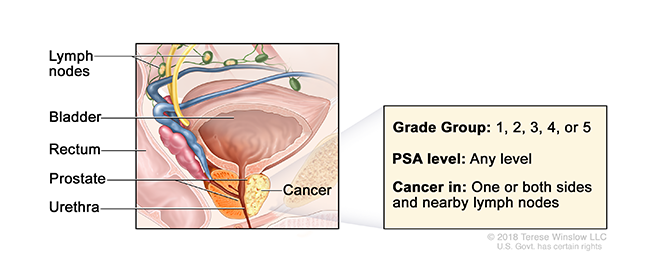Prostate Cancer Stages

Doctors label cancer by stages. Stages describe how much cancer is in your body, how far it has spread, and how quickly it may grow.
Stages help doctors and patients understand how serious cancer is. Staging also helps your care team plan how to best treat you.
What is cancer staging?
To stage prostate cancer, doctors use two types of information:
PSA level: PSA is a protein made by the prostate. Doctors use a blood test called a PSA test to measure your PSA level. PSA levels rise as people get older, so a normal level depends on your age. A higher level may be a sign of prostate cancer.
Gleason score: Doctors do a biopsy, taking a tiny sample of prostate tissue to look at under a microscope. If they find cancer, they rate how abnormal the cells look. This rating is called the Gleason score. It is used to put the cancer in a “grade group” from 1 to 5. A higher grade group means a higher risk of the cancer growing and spreading.
Understanding prostate cancer stages
Doctors describe prostate cancer stages with words and numbers.
Localized: The cancer is only in the prostate.
- Stage I: The cancer is small.
- Stage II: The cancer is larger.
Regional: Also called Stage III. The cancer may have spread outside the prostate to nearby tissues.
Distant: Also called Stage IV (4). The cancer has spread to other parts of the body.
Staging cancer is complicated. You can ask your doctor to explain it in ways that you understand. The Knight Cancer Institute is devoted to giving you the longest and best-quality of life possible.
Stage I
Cancer is only in the prostate gland. Your doctor may have found the cancer one of several ways:
- Through prostate surgery
- With a biopsy done because of your PSA level
- With a digital rectal exam
- In a scan
The PSA level is below 10. The grade group is 1.
Stage I Prostate Cancer

Stage II
Cancer is only in the prostate gland. Your doctor may have found the cancer one of several ways:
- Through prostate surgery
- With a biopsy done because of your PSA level
- With a digital rectal exam
- In a scan
The PSA level is below 20. The grade group is 1 to 4.
Stage IIA Prostate Cancer

Stage IIA: The tumor may be seen in a scan or felt. The grade group is 1. If the tumor can be seen or felt, it may also be:
- In half or less of one side of the prostate
- In more than half of one side of the prostate, or on both sides
Stage IIB: The tumor may be seen in a scan or felt. The grade group is 2.
Stage IIC: The tumor may be seen in a scan or felt. The grade group is 3 or 4.
Stage III
The cancer may have spread outside the prostate to nearby tissues. It has not spread to nearby lymph nodes or elsewhere in the body.
Stage IIIA Prostate Cancer

Stage IIIA: The cancer is only in the prostate gland. It may be seen in a scan or felt. The PSA level is 20 or above. The grade group is 1 to 4.
Stage IIIB: The cancer has spread outside the prostate. It may have spread to nearby tissue. The PSA level is any number. The grade group is 1 to 4.
Stage IIIC: The cancer may have spread outside the prostate. The PSA level is any number. The grade group is 5.
Stage IV
The cancer has spread outside the prostate gland. The PSA level and grade group are any number.
Stage IVA Prostate Cancer

Stage IVA: The cancer has spread to nearby lymph nodes. It may have spread to nearby tissues.
Stage IVB: The cancer has spread to distant parts of the body. It may have spread to nearby tissues or lymph nodes.
Learn more
- What are Prostate Cancer Stages and Grades, Zero Prostate Cancer
- Survival Rates for Prostate Cancer, American Cancer Society
For patients
Call 503-494-7999 to:
- Request an appointment
- Seek a second opinion
- Ask questions
Location
Knight Cancer Institute, South Waterfront
Center for Health & Healing, Building 2
3485 S. Bond Ave.
Portland, OR 97239
Free parking for patients and visitors
Refer a patient
- Refer your patient to OHSU.
- Call 503-494-4567 to seek provider-to-provider advice.
Cancer clinical trials
Clinical trials allow patients to try a new test or treatment.
Read more
Learn more about OHSU Knight Cancer Institute treatments: